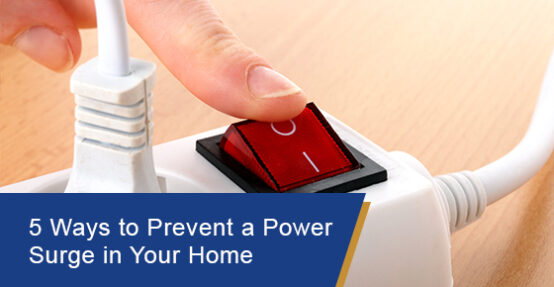
Electrical surges at home can cause serious damage to electronics, appliances, and plugged-in devices. While you might be aware of a severe surge that causes significant destruction, you may not notice many smaller surges lasting a microsecond or less. The harm they cause can be substantial over time.
Power surges can cause costly damage to expensive appliances, computers, and TVs. Here is an explanation of power surges and the steps you can take to prevent them while you’re at home.
A power surge in your home is a sudden increase in electrical voltage. Homes usually operate at 120 volts, with peaks of up to 169 volts. During a surge in voltage, the voltage rate suddenly spikes. During this rapid increase in voltage, too much electricity is pushed through your system, and it impacts all the devices connected to it.
Power surges are caused by a variety of factors, such as:
Lighting is among the fewest causes of power surges, but it can be the most dramatic. Millions of volts are discharged by nearby lightning strikes. You can actually blow up electrical devices when surges cross your home’s system. You can sustain severe injuries if you are nearby.
A common source of power surges are old, cracked, and frayed wiring, rodent-chewed wiring, and improperly installed wiring. Those experiencing flickering lights when their refrigerators start or hearing buzzing in their wiring could be at risk for power surges or even electrical fires.
Your electrical system may briefly be stressed when a compressor kicks on in a refrigerator or air conditioner. The increase in demand can cause a power surge by disrupting the normal flow of electricity. When your house is improperly wired, even the use of a hairdryer can result in such surges.
On a hot day when everyone is running their air conditioners, a power surge can occur when electricity demand exceeds supply. Energy providers may be unable to meet this demand. Temporary power failures, such as brownouts and blackouts, can cause voltages to dip before they spike destructively.
The system that flows electricity evenly and reliably into your home consists of a number of generators, lines, transformers, monitoring points and circuits, each of which is susceptible to power surges. When any point in the system malfunctions, the voltage can leap hundreds or thousands of volts. In less than a second, a surge can cause a great deal of damage. High voltage is difficult for most appliances and electronic devices, even for a brief moment.
Most likely to be damaged by a power surge are appliances and electronic devices such as the following:
You can protect yourself against the damage that power surges cause even though some kinds cannot be prevented.
A surge protector is a simple and inexpensive way to protect expensive electronics at home from power surges. They may not provide protection from lightning strikes, but they can give protection against the harm caused by the frequent, low-voltage surges we experience on a regular basis.
In order to protect your house from power surges, a whole-home surge protection system is often worth the investment. The heavy-duty surge protection systems protect your entire home, unlike surge protectors for individual devices. Lightning bursts are directed into the ground where they dissipate harmlessly. In order to keep your home safe from external surges, install a whole-home surge protection system. Adding surge protector power strips for key devices will guard against surges caused internally.
Lightning is rarely close enough to your electrical devices to damage them; however, the effects are devastating and dangerous. You can easily protect your home from the effects of a storm by unplugging major appliances, televisions, and computers when the storm is approaching. Power strips and whole-home surge protectors can both protect your electrical devices. The most effective protection is to disconnect. Therefore, make sure disconnecting is on top of your hurricane checklist.
Wiring problems are more than just a common cause of house fires; they are a major cause of power surges as well. Have your home’s electrical system inspected if it is an older home. These tests might uncover old cloth-wrapped wires, brittle insulation, or wires that aren’t rated to handle today’s devices.
You should inspect your wiring if rodents have been discovered in your home. In electrical junction boxes, rodents sometimes sharpen their teeth on wiring and build nests made of flammable materials.
Whenever possible, don’t plug too many devices into a single outlet. You might overload your system. In order to ensure your devices are protected, you should not put too many large appliances in a single outlet or nearby outlets that share the same circuit breaker. When the circuit is overloaded, the lines will overheat and voltage fluctuations will occur, which can damage the devices.
Electronic devices should be reset. Power surges can often cause devices to malfunction. Resets can restore them to working order.
Determine the extent of your home’s damage. Look for signs of damage to both devices and outlets, particularly if a spark has caused these to burn or if damaged components may malfunction and start a fire.
You may be able to get coverage for major damage if you know what needs to be repaired or replaced.
You should check your HVAC unit. If your HVAC unit is damaged in a power surge, then you may find yourself faced with an expensive, hazardous, or, at the very least, uncomfortable situation. Take action as soon as possible.
A power surge will occur in most homes at some point. Although they rarely cause noticeable damage to most devices, you should put precautions in place to protect your most expensive electronics. If you prevent power surges at home, you can avoid costly repairs and extend the life of your appliances and electronic devices.
Call Hi-Lite Electric now to speak to one of our helpful team members and set up an appointment for our electrician services.
© 2024 Licensed Electrical Installation & Service – Hi-Liteelectricinc.ca
All Rights Reserved.
Leave A Comment